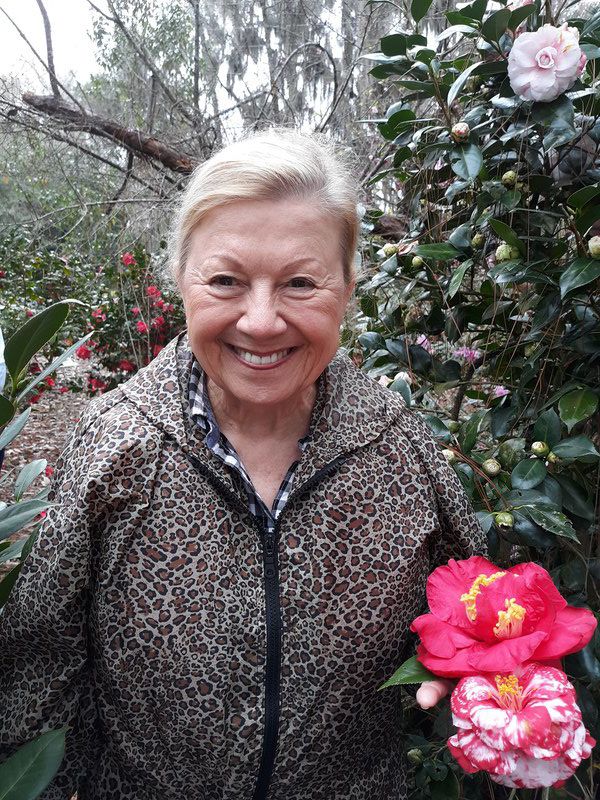GROOMS GARDENING: Check out nurseries for blooming plants
Published 8:00 am Sunday, March 1, 2020

- Submitted PhotoIngrid Savin holds two of her favorite camellias.
We have finally reached the first day of March. We have had a very good late-winter so far; cool mornings, some chilly nights and many beautiful sunny days, along with some cloudy, foggy days, even a few very warm days.
We have had several nippy frosts, but not had a severe killing freeze. Last weekend, it was supposed to be 30 degrees and the next morning my water buckets were frozen over, many plants were bitten back severely and the red hot pokers developed a droop in their scapes. But it was not a hard freeze.
Trending
I have not gotten much accomplished this year. My knee complains constantly when I am up on it and it is very happy when I’m in bed and it does not have any weight on it. So, I have spent quite a bit of time in or on the bed favoring my knee and drooling over gardening catalogs. I want one of every beautiful plant; while there are plants sitting in pots outside now that need planting, all beaming guilt at me for not getting them in the ground.
Knee surgery is scheduled in early March and I sure am looking forward to getting it fixed and getting past the pain and having a good knee again. I doubt I can dig with it, but it will be great to walk without pain.
Last week about 4 a.m. on a cold damp night, I heard what I thought was an owl being murdered by some animal, but the screaming kept up for about four minutes. Thinking that one of the stray cats in the neighborhood must have caught it, but was unable to kill it, I went limp-trotting out through the pecan orchard hoping to run the critter away and free the owl.
About 3/4 of the way there, a large armadillo hole dropped me face-first on the cold wet ground. I had a mouthful of leaves and dirt, knocked my glasses off, skinned my knees and really banged my face. I thought the grit in my mouth was a broken tooth, but fortunately it was just dirt. The next few days I looked like I had been knocked in the face, with a very red cheek, eye and nose. At least I didn’t get a black eye.
Jessica Commander, my beautiful niece, married her boyfriend of several years, Dylan Rogers, yesterday. She was a beautiful bride and Dylan was handsome. It was a lovely wedding at Twelve Oaks Plantation. I wish them the best of everything in their future.
I was going to have surgery prior to the wedding, but my surgeon said I was too old to walk on crutches, so surgery was postponed so I could attend.
Trending
I never knew that older people are not able to use crutches. I have a friend in North Georgia that owns a landscaping business and she broke her leg and hopped around for several months on steep slopes and terraced beds, with crutches, as she directed her crew.
Last week, my Amaryllis Garden Club went out to Mark Crawford’s Loch Laurel Nursery on a field trip. We were all amazed at the wonderland of camellias that were still in bloom. We thought the ones for sale were beautiful and full of blooms, but he said they were picked over as the season will be over soon.
Peak season or not, we saw thousands of beautiful blooms and all colors, and forms through several species. There were scented ones, small or midsize blooms, huge spectacular blooms in every shade of red, pink and white and every combination of the three colors and a pale yellow one. Forms varied greatly from bush to bush; single flowers in their pure simplicity to very frilly petals that are so numerous they hide the stamen that release pollen.
The American Camilla Society has several flower forms that are recognized for their shape, number of petals, placement and number of stamen plus other cultivar characteristics.
The visit to the nursery was a treat, it’s great to walk among the many types of Japanese Magnolias in his landscape, many still flowering or coloring the ground with their pedals. As with many gardeners, Mark likes exotic or unusual plants, and there are many scattered over his nursery grounds.
Are you old enough to remember Walker’s Garden Center and how much fun it was to wander through the shop, the greenhouses and even way-out, back to where plants were propagated and stored, Loch Laurel is also fun. All nurseries are a pleasure, but I love seeing plants in the landscape that have been growing there for years, seeing them combined and different or unusual plants, makes for an especially pleasant visit.
When I was a kid we bought a couple of parakeets from Walker’s Garden Center. I was always fascinated by the talking minor bird. Years after I married, I bought pansy plants in groups of 25, tied with a string, they cost $1 for 25 plants.
We are about to experience a great outburst of green. Every bud and leaf will consume a large amount of water, we are fortunate to have moist soil at this time. As plants absorb water from the soil, the abundance of water greatly impacts their growth rate. I have read one corn stalk needs 144 gallons of water to complete its life cycle and mature the corn.
Keep a watch out for scale. There are several types of scale, all have sucking mouth parts and draw sap from the plant. Different types of scale affect different plants.
There is what I call Turtle scale, it eventually forms a hard crust or shell over itself and is hard to kill by spraying unless you disturb the shell. It looks like bumpy bark until you look close, if in doubt, rub the bark with a stick to see if the bumps burst and have orange body fluid.
There is small flat white scale that looks like a dusting of powder over the foliage, often on tropical plants such as palms and birds of paradise.
There is a scale that looks slightly fluffy but not as fluffy as mealybugs. It is gray or white and often clusters near leaf joints and stems.
Some scale excrete honeydew which sooty mold will grow on. The mold filters out sunlight reducing the amount of energy the plant can produce.
Horticultural oil will kill most scale if sprayed directly upon the body. I like to use an insecticide that is not good for pollinators, it is Imidacloprid produced by Bayer company and sold under the name Bayer Advanced. The systemic insecticide will kill many flower pests including amaryllis weevil, most scales and any other plant sap-sucking insect. It is sold in granules and is effective when scattered around the plant for about three months.
If the systemic is used after the plants bloom, such as Japanese magnolia, the flowers have already been produced and pollinators will not be affected. For early blooming spring flowers, usually bulbs, trees and shrubs, these can be treated in fall and the insecticide will have faded out of the plants by the time they bloom in spring so the pollinators will not be affected.
It is almost dawn, I need to get to sleep. I can hear the birds beginning to sing. See you next week.





